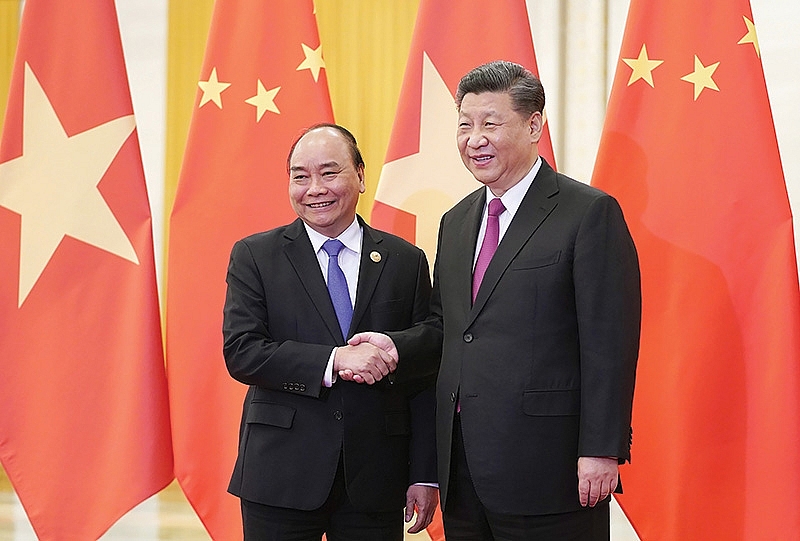Fortifying bilateral strategic relations
 |
| PM Nguyen Xuan Phuc and Party General Secretary, State President Xi Jinping, Photo: VGP |
Prime Minister Nguyen Xuan Phuc last week set foot in China to attend the second Belt and Road Forum for International Co-operation organised on April 25-27. He also met with Chinese Party General Secretary, State President Xi Jinping and Chinese Premier Li Keqiang. Both sides stressed that the two nations’ comprehensive strategic co-operative partnership must continue to be developed stably and healthily.
Vietnam and China inked some co-operation deals, including a technical economic agreement between both governments, a protocol between Vietnam’s Ministry of Agriculture and Rural Development and China’s General Administration of Customs on requirements for Vietnamese milk products exported to China, and a co-operation plan between Vietnam’s Ministry of Culture, Sports and Tourism, and China’s Ministry of Culture and Tourism for the 2019-2021 period.
Especially, PM Phuc said that Vietnam welcomed big projects from China with advanced, environmentally friendly technology. He also met with some Chinese businesses operating in infrastructure, energy, technology, and finance.
Currently, both countries are party to the ASEAN-China Free Trade Agreement, and are currently negotiating the Regional Comprehensive Economic Partnership, which includes the ASEAN member states and the six states with which the ASEAN has existing free trade agreements (Australia, China, India, Japan, South Korea, and New Zealand).
For the past few decades, Chinese investment in Vietnam and bilateral trade have been growing steadily. China’s first investment in Vietnam was made in 1991 when a Guangxi enterprise established a joint venture with a Vietnamese group to open Hoa Long restaurant in Hanoi.
According to the Ministry of Planning and Investment, in 2015 China had 1,284 projects in Vietnam, registered at $9.9 billion, making China Vietnam’s ninth largest foreign investor. The figures rose to 1,555 projects registered at $10.52 billion in 2016 – lifting China to the eight position – and 1,883 projects with $12.44 billion in 2017 – scoring seventh. However, as of April 20, 2019, China had 2,343 projects registered at $14.86 billion. In the first four months of 2019, China was Vietnam’s fourth largest foreign investor, with 187 projects registered at $1.3 billion. If stake acquisitions and capital expansion at operational projects are included, total Chinese newly-registered capital mounted to over $1.7 billion.
China has constructed large-scale projects in Vietnam, such as the $2 billion Vinh Tan 1 Thermal Power Plant in the south-central province of Binh Thuan, and the $1.85 billion Hai Duong Thermal Power Plant in northern Hai Duong, and a $400 million automobile tire manufacturing project in the southwestern province of Tay Ninh.
Regarding bilateral trade, according to the General Statistics Office, two-way trade turnover between Vietnam and China has increased by more than 20 per cent on average over the past five years. It reached $107.7 billion last year, up from $93.69 billion in 2017.
The figure hit $22.6 billion in the first quarter of 2019, with Vietnam spending $15 billion on imports and earning $7.6 billion from exports.
Over 70 per cent of Chinese imports in Vietnam are intermediate goods such as machinery, electrical and electronic products, textiles and fabrics, base metals and minerals, and chemicals. Meanwhile, major Vietnamese exports to China include machinery, electrical and electronic products, food, cotton, fuel, and oil products.
To lure in more Chinese investors and boost Vietnamese exports to China, the Vietnamese Ministry of Industry and Trade has established the second Vietnamese trade and investment promotion office in Hangzhou city of Zhejiang province. The first office was opened in China’s Chongqing municipality in 2015.
During Party General Secretary Nguyen Phu Trong’s official visit on January 12-15, 2017 to China, the two countries inked 15 co-operation deals on training, infrastructure, defence, land border gates, public health, tourism, television and radio, and banking.
The two sides reached a consensus on forging stronger win-win co-operation in economy, trade, and investment. They also urged ministries, localities, and businesses to concentrate on effectively deploying already agreed plans, programmes, and projects.
Chinese leader Xi Jinping pledged to encourage Chinese enterprises to boost the import of Vietnamese agro-forestry-fishery as well as dairy products and processed fruits, and carry out hi-tech and environmentally friendly projects in Vietnam. The two sides also agreed to amplify co-operation in science-technology, agriculture, environment, and climate change response.
Last week, PM Phuc also stated that Vietnam welcomes and supports the Belt and Road Initiative (BRI) on the basis of ensuring the principles of peaceful, equal, and win-win co-operation, mutual respect, and adherence to international laws in order to contribute to the common development and prosperity of all countries.
The BRI forum saw the participation of 40 national leaders, seven of whom were visiting China.
What the stars mean:
★ Poor ★ ★ Promising ★★★ Good ★★★★ Very good ★★★★★ Exceptional
 Tag:
Tag:
Related Contents
Latest News
More News
- EVN launches major power infrastructure projects nationwide (December 19, 2025 | 18:17)
- VAL inaugurates second production line to meet domestic animal feed demand (December 19, 2025 | 16:37)
- Sun Group pioneers urban tram system in Phu Quoc (December 19, 2025 | 15:00)
- Seven major projects launched to drive Hanoi’s next growth phase (December 19, 2025 | 14:00)
- Securing capital and efficiency for Vietnam’s 2026-2030 growth ambitions (December 17, 2025 | 10:00)
- Vietnam bucking trend in the global M&A landscape (December 16, 2025 | 14:20)
- HDS Summit spotlights Vietnam’s rising role in regional supply chains (December 16, 2025 | 08:00)
- Kolon signs $48 million airbag supply deal with Autoliv (December 15, 2025 | 18:14)
- National Assembly approves Vinh–Thanh Thuy expressway project (December 15, 2025 | 18:02)
- Quang Tri green-lights $1.59 billion LNG-fired power project (December 15, 2025 | 17:59)
























 Mobile Version
Mobile Version